LST5CCL Company and Commercial Law Case Study: Partnership Analysis
VerifiedAdded on 2023/06/11
|12
|3907
|145
Case Study
AI Summary
This case study provides an analysis of a business scenario involving Julio, Carolyn, and Trisha, focusing on their business structure, individual and joint liabilities, and recommendations for improvement. It examines the legal provisions related to partnerships, particularly concerning profit and loss sharing, partner rights, and liability for business debts. The study references relevant case law, such as Smith v Anderson and Canny Gabriel Castle Advertising Pty Ltd & Anor v Volume Sales (Finance) Pty Ltd, to support its analysis. The document concludes that Julio, Carolyn, and Trisha are partners due to their joint ownership, profit and loss sharing, and exercise of partner rights, while Sarah is considered a loan provider. Furthermore, it determines that all partners are responsible for losses incurred due to their collective decisions, referencing the Partnership Act and the case of Wang v Rong to reinforce the principle of mutual and strict liability among partners.
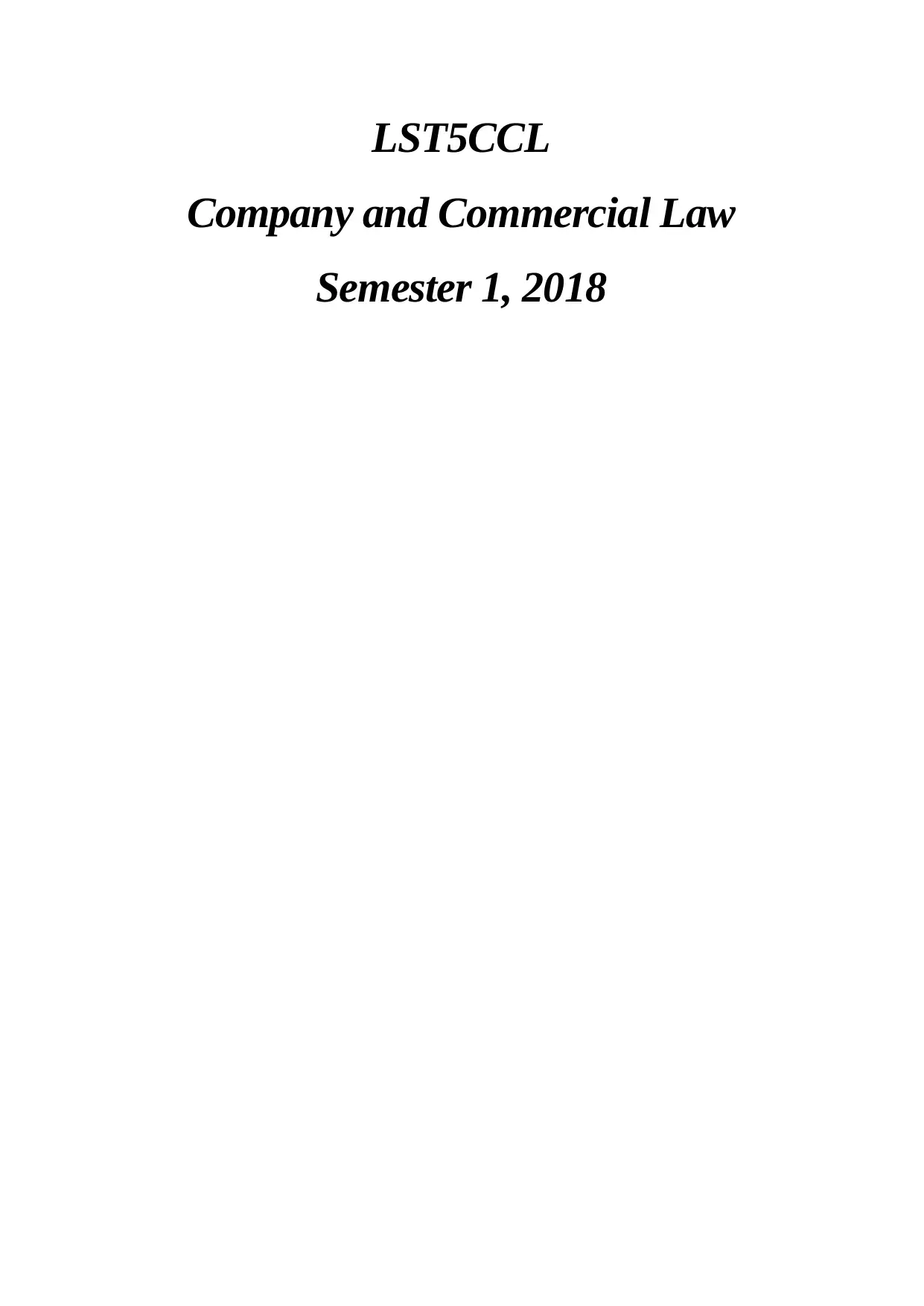
LST5CCL
Company and Commercial Law
Semester 1, 2018
Company and Commercial Law
Semester 1, 2018
Secure Best Marks with AI Grader
Need help grading? Try our AI Grader for instant feedback on your assignments.
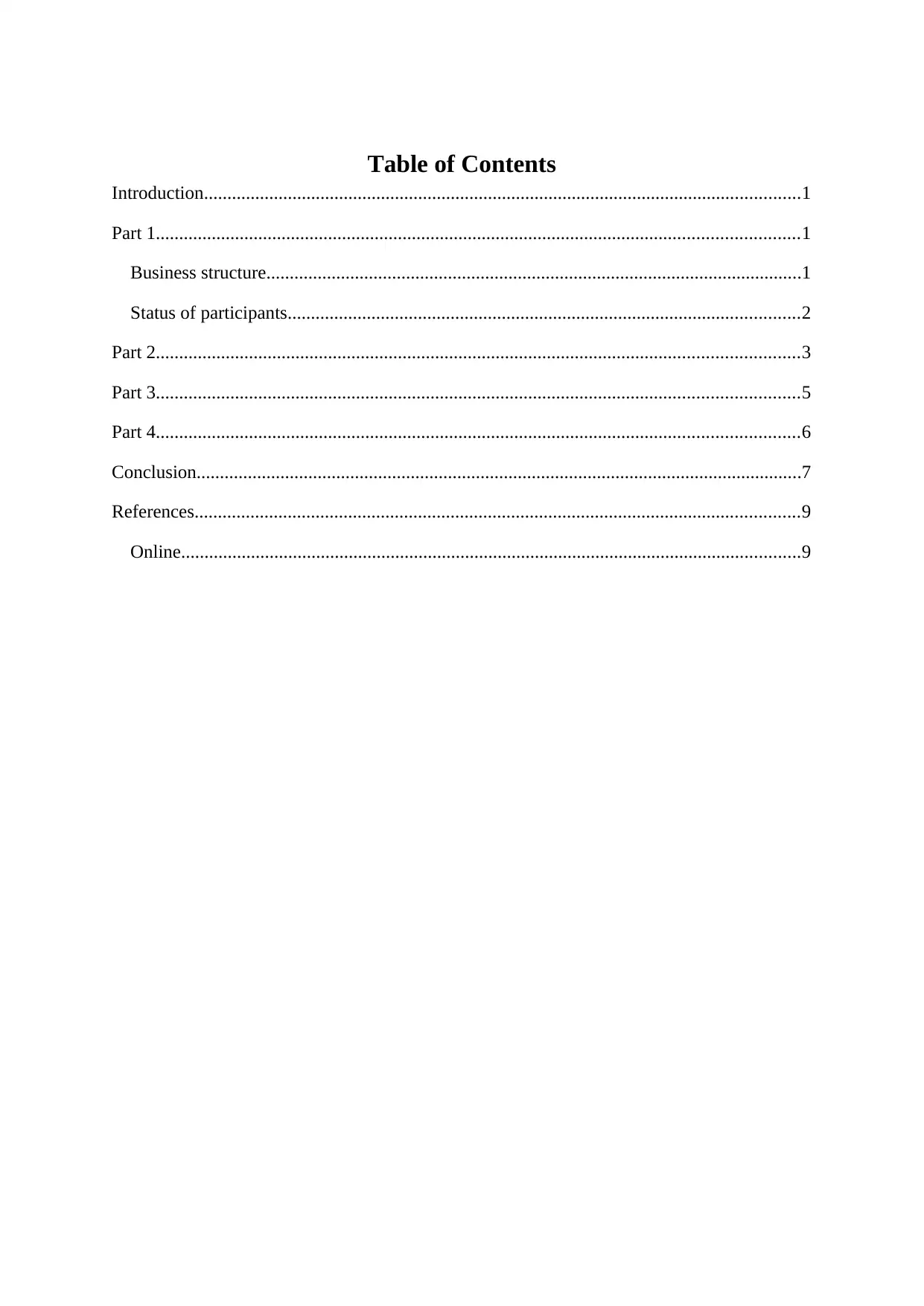
Table of Contents
Introduction................................................................................................................................1
Part 1..........................................................................................................................................1
Business structure...................................................................................................................1
Status of participants..............................................................................................................2
Part 2..........................................................................................................................................3
Part 3..........................................................................................................................................5
Part 4..........................................................................................................................................6
Conclusion..................................................................................................................................7
References..................................................................................................................................9
Online.....................................................................................................................................9
Introduction................................................................................................................................1
Part 1..........................................................................................................................................1
Business structure...................................................................................................................1
Status of participants..............................................................................................................2
Part 2..........................................................................................................................................3
Part 3..........................................................................................................................................5
Part 4..........................................................................................................................................6
Conclusion..................................................................................................................................7
References..................................................................................................................................9
Online.....................................................................................................................................9
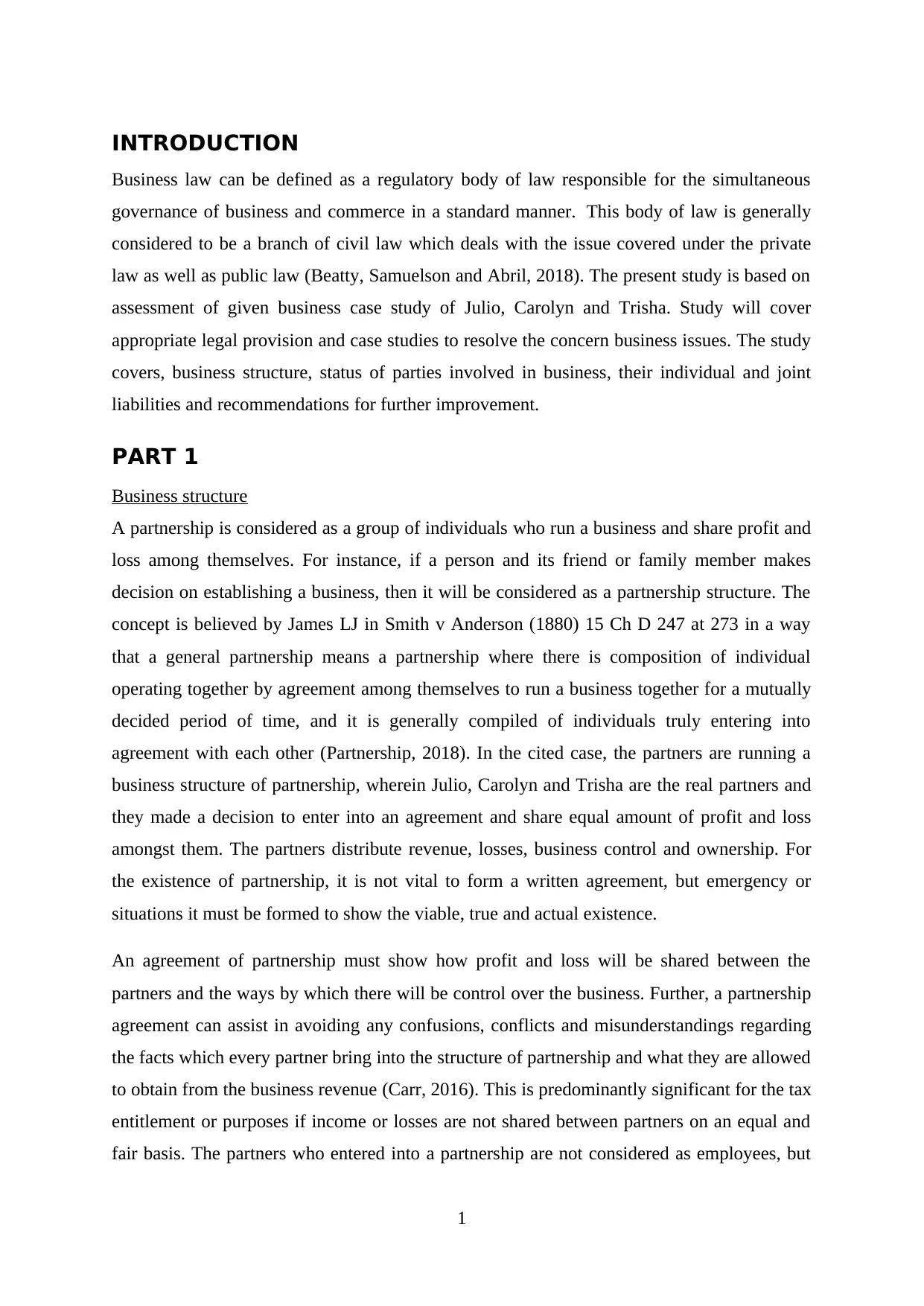
INTRODUCTION
Business law can be defined as a regulatory body of law responsible for the simultaneous
governance of business and commerce in a standard manner. This body of law is generally
considered to be a branch of civil law which deals with the issue covered under the private
law as well as public law (Beatty, Samuelson and Abril, 2018). The present study is based on
assessment of given business case study of Julio, Carolyn and Trisha. Study will cover
appropriate legal provision and case studies to resolve the concern business issues. The study
covers, business structure, status of parties involved in business, their individual and joint
liabilities and recommendations for further improvement.
PART 1
Business structure
A partnership is considered as a group of individuals who run a business and share profit and
loss among themselves. For instance, if a person and its friend or family member makes
decision on establishing a business, then it will be considered as a partnership structure. The
concept is believed by James LJ in Smith v Anderson (1880) 15 Ch D 247 at 273 in a way
that a general partnership means a partnership where there is composition of individual
operating together by agreement among themselves to run a business together for a mutually
decided period of time, and it is generally compiled of individuals truly entering into
agreement with each other (Partnership, 2018). In the cited case, the partners are running a
business structure of partnership, wherein Julio, Carolyn and Trisha are the real partners and
they made a decision to enter into an agreement and share equal amount of profit and loss
amongst them. The partners distribute revenue, losses, business control and ownership. For
the existence of partnership, it is not vital to form a written agreement, but emergency or
situations it must be formed to show the viable, true and actual existence.
An agreement of partnership must show how profit and loss will be shared between the
partners and the ways by which there will be control over the business. Further, a partnership
agreement can assist in avoiding any confusions, conflicts and misunderstandings regarding
the facts which every partner bring into the structure of partnership and what they are allowed
to obtain from the business revenue (Carr, 2016). This is predominantly significant for the tax
entitlement or purposes if income or losses are not shared between partners on an equal and
fair basis. The partners who entered into a partnership are not considered as employees, but
1
Business law can be defined as a regulatory body of law responsible for the simultaneous
governance of business and commerce in a standard manner. This body of law is generally
considered to be a branch of civil law which deals with the issue covered under the private
law as well as public law (Beatty, Samuelson and Abril, 2018). The present study is based on
assessment of given business case study of Julio, Carolyn and Trisha. Study will cover
appropriate legal provision and case studies to resolve the concern business issues. The study
covers, business structure, status of parties involved in business, their individual and joint
liabilities and recommendations for further improvement.
PART 1
Business structure
A partnership is considered as a group of individuals who run a business and share profit and
loss among themselves. For instance, if a person and its friend or family member makes
decision on establishing a business, then it will be considered as a partnership structure. The
concept is believed by James LJ in Smith v Anderson (1880) 15 Ch D 247 at 273 in a way
that a general partnership means a partnership where there is composition of individual
operating together by agreement among themselves to run a business together for a mutually
decided period of time, and it is generally compiled of individuals truly entering into
agreement with each other (Partnership, 2018). In the cited case, the partners are running a
business structure of partnership, wherein Julio, Carolyn and Trisha are the real partners and
they made a decision to enter into an agreement and share equal amount of profit and loss
amongst them. The partners distribute revenue, losses, business control and ownership. For
the existence of partnership, it is not vital to form a written agreement, but emergency or
situations it must be formed to show the viable, true and actual existence.
An agreement of partnership must show how profit and loss will be shared between the
partners and the ways by which there will be control over the business. Further, a partnership
agreement can assist in avoiding any confusions, conflicts and misunderstandings regarding
the facts which every partner bring into the structure of partnership and what they are allowed
to obtain from the business revenue (Carr, 2016). This is predominantly significant for the tax
entitlement or purposes if income or losses are not shared between partners on an equal and
fair basis. The partners who entered into a partnership are not considered as employees, but
1
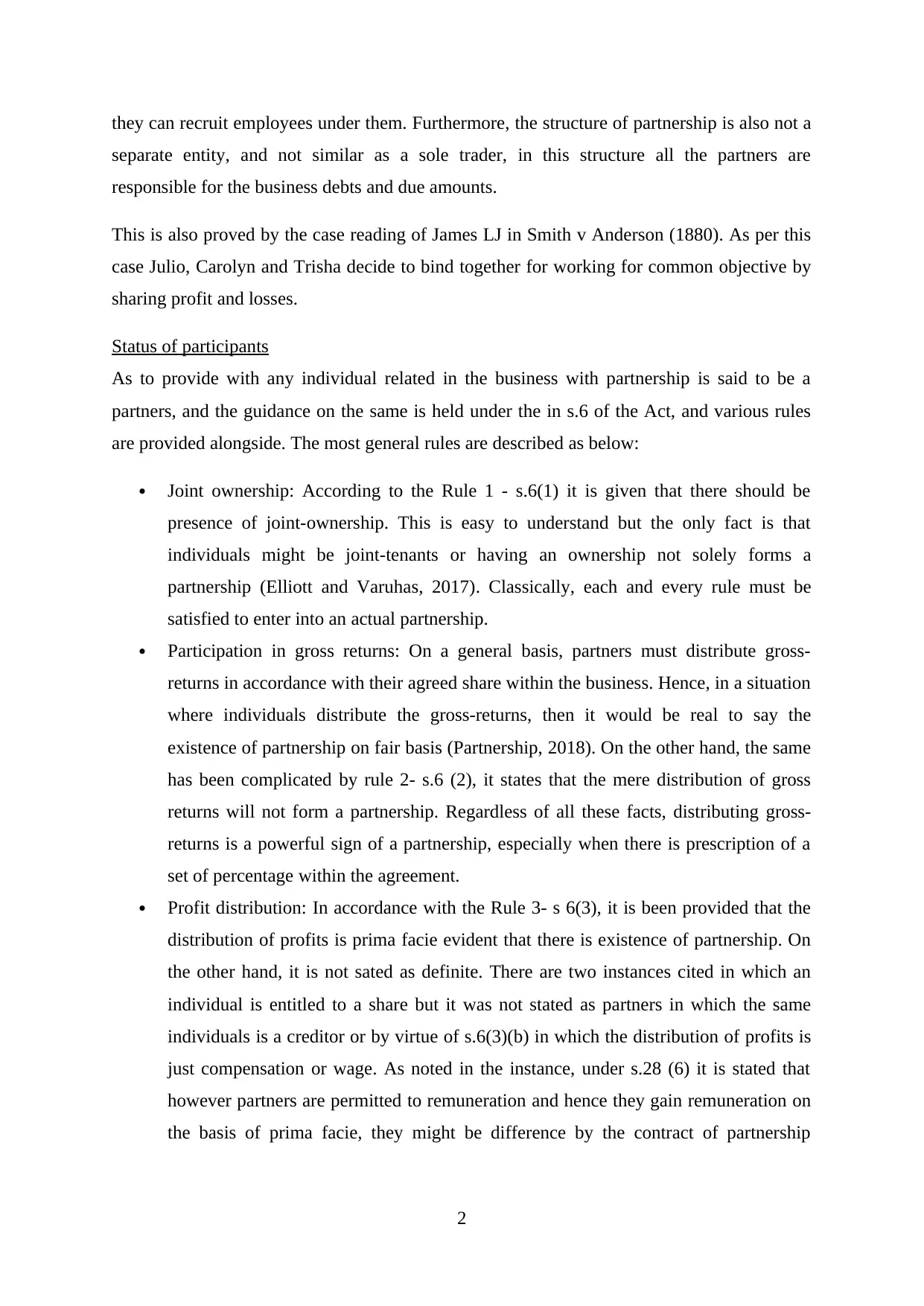
they can recruit employees under them. Furthermore, the structure of partnership is also not a
separate entity, and not similar as a sole trader, in this structure all the partners are
responsible for the business debts and due amounts.
This is also proved by the case reading of James LJ in Smith v Anderson (1880). As per this
case Julio, Carolyn and Trisha decide to bind together for working for common objective by
sharing profit and losses.
Status of participants
As to provide with any individual related in the business with partnership is said to be a
partners, and the guidance on the same is held under the in s.6 of the Act, and various rules
are provided alongside. The most general rules are described as below:
Joint ownership: According to the Rule 1 - s.6(1) it is given that there should be
presence of joint-ownership. This is easy to understand but the only fact is that
individuals might be joint-tenants or having an ownership not solely forms a
partnership (Elliott and Varuhas, 2017). Classically, each and every rule must be
satisfied to enter into an actual partnership.
Participation in gross returns: On a general basis, partners must distribute gross-
returns in accordance with their agreed share within the business. Hence, in a situation
where individuals distribute the gross-returns, then it would be real to say the
existence of partnership on fair basis (Partnership, 2018). On the other hand, the same
has been complicated by rule 2- s.6 (2), it states that the mere distribution of gross
returns will not form a partnership. Regardless of all these facts, distributing gross-
returns is a powerful sign of a partnership, especially when there is prescription of a
set of percentage within the agreement.
Profit distribution: In accordance with the Rule 3- s 6(3), it is been provided that the
distribution of profits is prima facie evident that there is existence of partnership. On
the other hand, it is not sated as definite. There are two instances cited in which an
individual is entitled to a share but it was not stated as partners in which the same
individuals is a creditor or by virtue of s.6(3)(b) in which the distribution of profits is
just compensation or wage. As noted in the instance, under s.28 (6) it is stated that
however partners are permitted to remuneration and hence they gain remuneration on
the basis of prima facie, they might be difference by the contract of partnership
2
separate entity, and not similar as a sole trader, in this structure all the partners are
responsible for the business debts and due amounts.
This is also proved by the case reading of James LJ in Smith v Anderson (1880). As per this
case Julio, Carolyn and Trisha decide to bind together for working for common objective by
sharing profit and losses.
Status of participants
As to provide with any individual related in the business with partnership is said to be a
partners, and the guidance on the same is held under the in s.6 of the Act, and various rules
are provided alongside. The most general rules are described as below:
Joint ownership: According to the Rule 1 - s.6(1) it is given that there should be
presence of joint-ownership. This is easy to understand but the only fact is that
individuals might be joint-tenants or having an ownership not solely forms a
partnership (Elliott and Varuhas, 2017). Classically, each and every rule must be
satisfied to enter into an actual partnership.
Participation in gross returns: On a general basis, partners must distribute gross-
returns in accordance with their agreed share within the business. Hence, in a situation
where individuals distribute the gross-returns, then it would be real to say the
existence of partnership on fair basis (Partnership, 2018). On the other hand, the same
has been complicated by rule 2- s.6 (2), it states that the mere distribution of gross
returns will not form a partnership. Regardless of all these facts, distributing gross-
returns is a powerful sign of a partnership, especially when there is prescription of a
set of percentage within the agreement.
Profit distribution: In accordance with the Rule 3- s 6(3), it is been provided that the
distribution of profits is prima facie evident that there is existence of partnership. On
the other hand, it is not sated as definite. There are two instances cited in which an
individual is entitled to a share but it was not stated as partners in which the same
individuals is a creditor or by virtue of s.6(3)(b) in which the distribution of profits is
just compensation or wage. As noted in the instance, under s.28 (6) it is stated that
however partners are permitted to remuneration and hence they gain remuneration on
the basis of prima facie, they might be difference by the contract of partnership
2
Secure Best Marks with AI Grader
Need help grading? Try our AI Grader for instant feedback on your assignments.

(Davidson, Forsythe and Knowles, 2015). Hence, obtaining remuneration does not
exclusively sign in opposition with a partnership.
Loss distribution: It is concerned by Rule 3 – s6 (3) that states that in partnership there
must be equal distribution of profits. In addition, it is been explained by Section 28
that each partner should make contribution towards the business losses in an equal
manner.
Practising partner rights: Usually, when a partner is engaged with partner right and
exercise them in full power, then only they will be said as active partners. It is more
expected that a partnership can be attributed (Gullifer and Payne, 2015). Generally,
where a person exercises those rights that would typically be exercised by a true
partner, the more likely a partnership can be imputing. Section 28 includes a non-
exhaustive list of partner’s rights.
The High Court was experienced with the same problem in the Canny Gabriel Castle
Advertising Pty Ltd &Anor v Volume Sales (Finance) Pty Ltd (1974) 131
CLR 321. In other terms, it is clear that the agreement highlights all the signs of a
partnership, exclusive of one that it does not depicts the parties as partners and have not
offered the distribution of profits, however, business projects to think on the same implied
situation.
By considering the case reading of Canny Gabriel Castle Advertising Pty
Ltd &Anor v Volume Sales (Finance) Pty Ltd (1974), Julio, Carolyn and Trisha
are partners as they satisfied all the characteristics of partnership that is to having joint
ownership, sharing in profit and loss and having all accessible rights of a partner. On the
other hand, Sarah is mere loan provider. As per the case reading, mere profit distribution
characteristic is not sole basis to determine the status of a partnership. In the concerned case,
Sarah’s interest is to help her sister out, and she is entitled to profit in the form of interest
instead of having any other interest in the business.
PART 2
All partners are said to be the agents of business and their other partners for the intention of
the partnership business and the acting and actions of every partner who conduct any actions
for running the business in a general way, which is carried out by the business in the same
way then the firm is bounded with firm and partners, unless and until the partner’s acting has
no power to act for the business in a specified manner and the individuals with whom the
3
exclusively sign in opposition with a partnership.
Loss distribution: It is concerned by Rule 3 – s6 (3) that states that in partnership there
must be equal distribution of profits. In addition, it is been explained by Section 28
that each partner should make contribution towards the business losses in an equal
manner.
Practising partner rights: Usually, when a partner is engaged with partner right and
exercise them in full power, then only they will be said as active partners. It is more
expected that a partnership can be attributed (Gullifer and Payne, 2015). Generally,
where a person exercises those rights that would typically be exercised by a true
partner, the more likely a partnership can be imputing. Section 28 includes a non-
exhaustive list of partner’s rights.
The High Court was experienced with the same problem in the Canny Gabriel Castle
Advertising Pty Ltd &Anor v Volume Sales (Finance) Pty Ltd (1974) 131
CLR 321. In other terms, it is clear that the agreement highlights all the signs of a
partnership, exclusive of one that it does not depicts the parties as partners and have not
offered the distribution of profits, however, business projects to think on the same implied
situation.
By considering the case reading of Canny Gabriel Castle Advertising Pty
Ltd &Anor v Volume Sales (Finance) Pty Ltd (1974), Julio, Carolyn and Trisha
are partners as they satisfied all the characteristics of partnership that is to having joint
ownership, sharing in profit and loss and having all accessible rights of a partner. On the
other hand, Sarah is mere loan provider. As per the case reading, mere profit distribution
characteristic is not sole basis to determine the status of a partnership. In the concerned case,
Sarah’s interest is to help her sister out, and she is entitled to profit in the form of interest
instead of having any other interest in the business.
PART 2
All partners are said to be the agents of business and their other partners for the intention of
the partnership business and the acting and actions of every partner who conduct any actions
for running the business in a general way, which is carried out by the business in the same
way then the firm is bounded with firm and partners, unless and until the partner’s acting has
no power to act for the business in a specified manner and the individuals with whom the
3
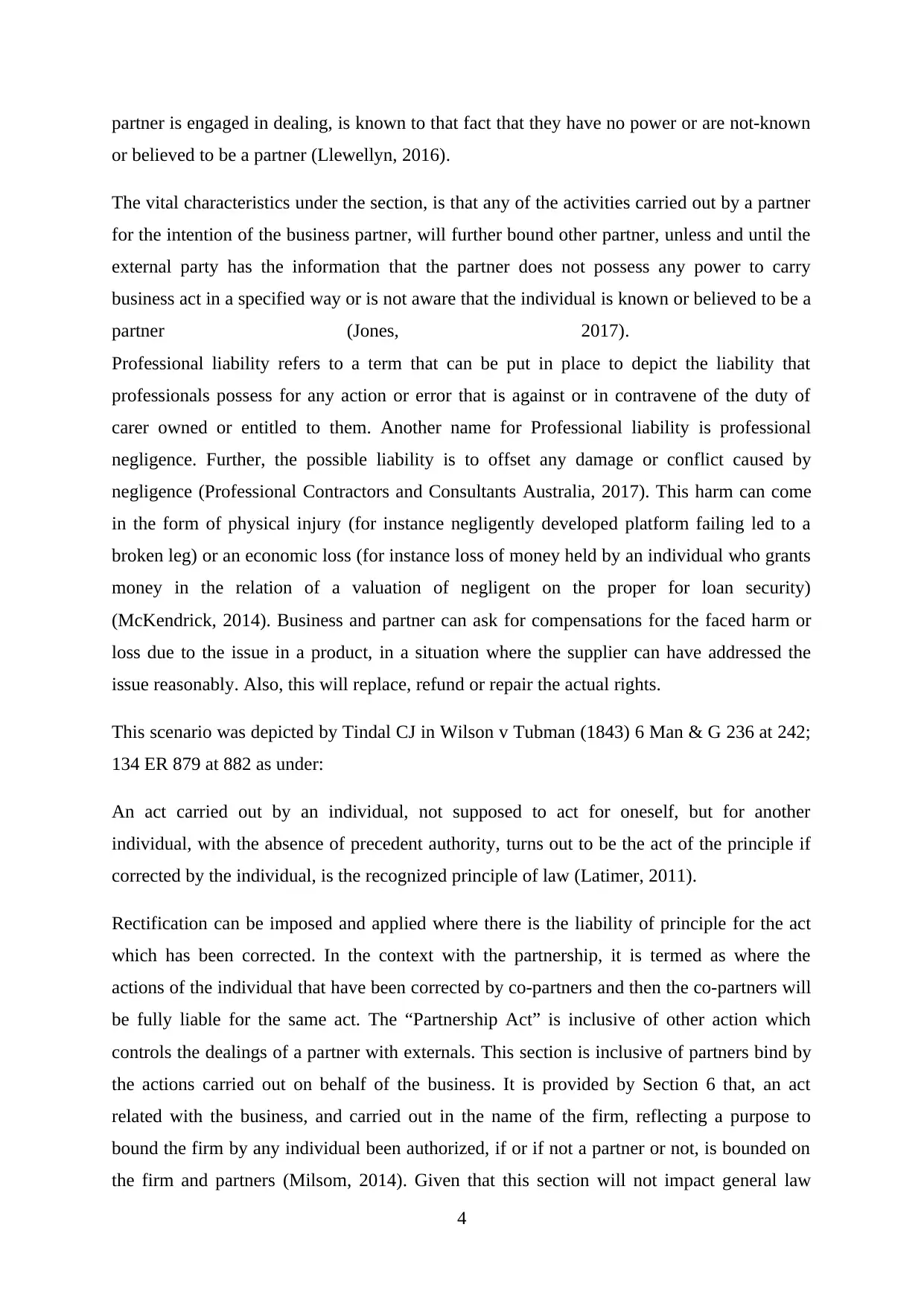
partner is engaged in dealing, is known to that fact that they have no power or are not-known
or believed to be a partner (Llewellyn, 2016).
The vital characteristics under the section, is that any of the activities carried out by a partner
for the intention of the business partner, will further bound other partner, unless and until the
external party has the information that the partner does not possess any power to carry
business act in a specified way or is not aware that the individual is known or believed to be a
partner (Jones, 2017).
Professional liability refers to a term that can be put in place to depict the liability that
professionals possess for any action or error that is against or in contravene of the duty of
carer owned or entitled to them. Another name for Professional liability is professional
negligence. Further, the possible liability is to offset any damage or conflict caused by
negligence (Professional Contractors and Consultants Australia, 2017). This harm can come
in the form of physical injury (for instance negligently developed platform failing led to a
broken leg) or an economic loss (for instance loss of money held by an individual who grants
money in the relation of a valuation of negligent on the proper for loan security)
(McKendrick, 2014). Business and partner can ask for compensations for the faced harm or
loss due to the issue in a product, in a situation where the supplier can have addressed the
issue reasonably. Also, this will replace, refund or repair the actual rights.
This scenario was depicted by Tindal CJ in Wilson v Tubman (1843) 6 Man & G 236 at 242;
134 ER 879 at 882 as under:
An act carried out by an individual, not supposed to act for oneself, but for another
individual, with the absence of precedent authority, turns out to be the act of the principle if
corrected by the individual, is the recognized principle of law (Latimer, 2011).
Rectification can be imposed and applied where there is the liability of principle for the act
which has been corrected. In the context with the partnership, it is termed as where the
actions of the individual that have been corrected by co-partners and then the co-partners will
be fully liable for the same act. The “Partnership Act” is inclusive of other action which
controls the dealings of a partner with externals. This section is inclusive of partners bind by
the actions carried out on behalf of the business. It is provided by Section 6 that, an act
related with the business, and carried out in the name of the firm, reflecting a purpose to
bound the firm by any individual been authorized, if or if not a partner or not, is bounded on
the firm and partners (Milsom, 2014). Given that this section will not impact general law
4
or believed to be a partner (Llewellyn, 2016).
The vital characteristics under the section, is that any of the activities carried out by a partner
for the intention of the business partner, will further bound other partner, unless and until the
external party has the information that the partner does not possess any power to carry
business act in a specified way or is not aware that the individual is known or believed to be a
partner (Jones, 2017).
Professional liability refers to a term that can be put in place to depict the liability that
professionals possess for any action or error that is against or in contravene of the duty of
carer owned or entitled to them. Another name for Professional liability is professional
negligence. Further, the possible liability is to offset any damage or conflict caused by
negligence (Professional Contractors and Consultants Australia, 2017). This harm can come
in the form of physical injury (for instance negligently developed platform failing led to a
broken leg) or an economic loss (for instance loss of money held by an individual who grants
money in the relation of a valuation of negligent on the proper for loan security)
(McKendrick, 2014). Business and partner can ask for compensations for the faced harm or
loss due to the issue in a product, in a situation where the supplier can have addressed the
issue reasonably. Also, this will replace, refund or repair the actual rights.
This scenario was depicted by Tindal CJ in Wilson v Tubman (1843) 6 Man & G 236 at 242;
134 ER 879 at 882 as under:
An act carried out by an individual, not supposed to act for oneself, but for another
individual, with the absence of precedent authority, turns out to be the act of the principle if
corrected by the individual, is the recognized principle of law (Latimer, 2011).
Rectification can be imposed and applied where there is the liability of principle for the act
which has been corrected. In the context with the partnership, it is termed as where the
actions of the individual that have been corrected by co-partners and then the co-partners will
be fully liable for the same act. The “Partnership Act” is inclusive of other action which
controls the dealings of a partner with externals. This section is inclusive of partners bind by
the actions carried out on behalf of the business. It is provided by Section 6 that, an act
related with the business, and carried out in the name of the firm, reflecting a purpose to
bound the firm by any individual been authorized, if or if not a partner or not, is bounded on
the firm and partners (Milsom, 2014). Given that this section will not impact general law
4

rules regarding the implementation of agreements. This sections is referred as those acts that
are carried out with the purpose of binding the firm and thereby shall bind the firm.
By considering the above case, it can be said that all the partners will be responsible for the
loss, as the loss was made according to the decision of all partners and all the partners were
engaged in the act which resulted into a business loss. Further, according to the Partnership
Act, it is clear that if the act or conduct of partners holds the loss or damage, and all the
partners are involved in the same, then the loss would be fully entitled to them. They have to
mutually and strictly share the loss and are liable on the same. Hence, Julio and all the
associated business partners are liable for the damages suffered by X.
In the case study of Wang v Rong [2015] NSWSC 1419 the problem was if or if not Wang,
Rong and Zhang were mutually and strictly responsible for the Partnership debts (Partnership
dispute: Wang v Rong [2015] NSWSC 1419, 2016). The court further declared that all the
three involved partners are mutually and strictly responsible for the debts in their partnership
structure.
PART 3
Any person who grants advice to another person or either offers a service of a professional
character as per a set discipline can be defined as professional. Further, a professional is only
responsible for offsetting to those who have the entitlement to the duty of care by the
professional (Storey, 2016). Generally, a professional will be found to be obliged to a duty of
care to all the individuals whom the professional shall foresee can be damaged or experienced
losses reasonably by a negligent action or error.
There are three core fundaments to set negligence, first and the most important is that there
should be the presence of amongst the parties, next the professional must never practice the
needed standard of care leading to omission and the last is the omissions causing damages to
the other related parties to correct and fix the omission. If there is the absence of these three
fundaments being set, it is not possible to establish a claim for harm, injury or loss. An act
would not be negligent due to the extraordinary capabilities of professional (KEY ASPECTS
OF THE LAW OF CONTRACT AND THE TORT OF NEGLIGENCE, 2018). On the other
hand, it would be negligent, in case the work declined below the competence level. The
extent of care needed will be based on the possible loss risk and the reasonability of the
avoidable measures that are required to be considered.
5
are carried out with the purpose of binding the firm and thereby shall bind the firm.
By considering the above case, it can be said that all the partners will be responsible for the
loss, as the loss was made according to the decision of all partners and all the partners were
engaged in the act which resulted into a business loss. Further, according to the Partnership
Act, it is clear that if the act or conduct of partners holds the loss or damage, and all the
partners are involved in the same, then the loss would be fully entitled to them. They have to
mutually and strictly share the loss and are liable on the same. Hence, Julio and all the
associated business partners are liable for the damages suffered by X.
In the case study of Wang v Rong [2015] NSWSC 1419 the problem was if or if not Wang,
Rong and Zhang were mutually and strictly responsible for the Partnership debts (Partnership
dispute: Wang v Rong [2015] NSWSC 1419, 2016). The court further declared that all the
three involved partners are mutually and strictly responsible for the debts in their partnership
structure.
PART 3
Any person who grants advice to another person or either offers a service of a professional
character as per a set discipline can be defined as professional. Further, a professional is only
responsible for offsetting to those who have the entitlement to the duty of care by the
professional (Storey, 2016). Generally, a professional will be found to be obliged to a duty of
care to all the individuals whom the professional shall foresee can be damaged or experienced
losses reasonably by a negligent action or error.
There are three core fundaments to set negligence, first and the most important is that there
should be the presence of amongst the parties, next the professional must never practice the
needed standard of care leading to omission and the last is the omissions causing damages to
the other related parties to correct and fix the omission. If there is the absence of these three
fundaments being set, it is not possible to establish a claim for harm, injury or loss. An act
would not be negligent due to the extraordinary capabilities of professional (KEY ASPECTS
OF THE LAW OF CONTRACT AND THE TORT OF NEGLIGENCE, 2018). On the other
hand, it would be negligent, in case the work declined below the competence level. The
extent of care needed will be based on the possible loss risk and the reasonability of the
avoidable measures that are required to be considered.
5
Paraphrase This Document
Need a fresh take? Get an instant paraphrase of this document with our AI Paraphraser
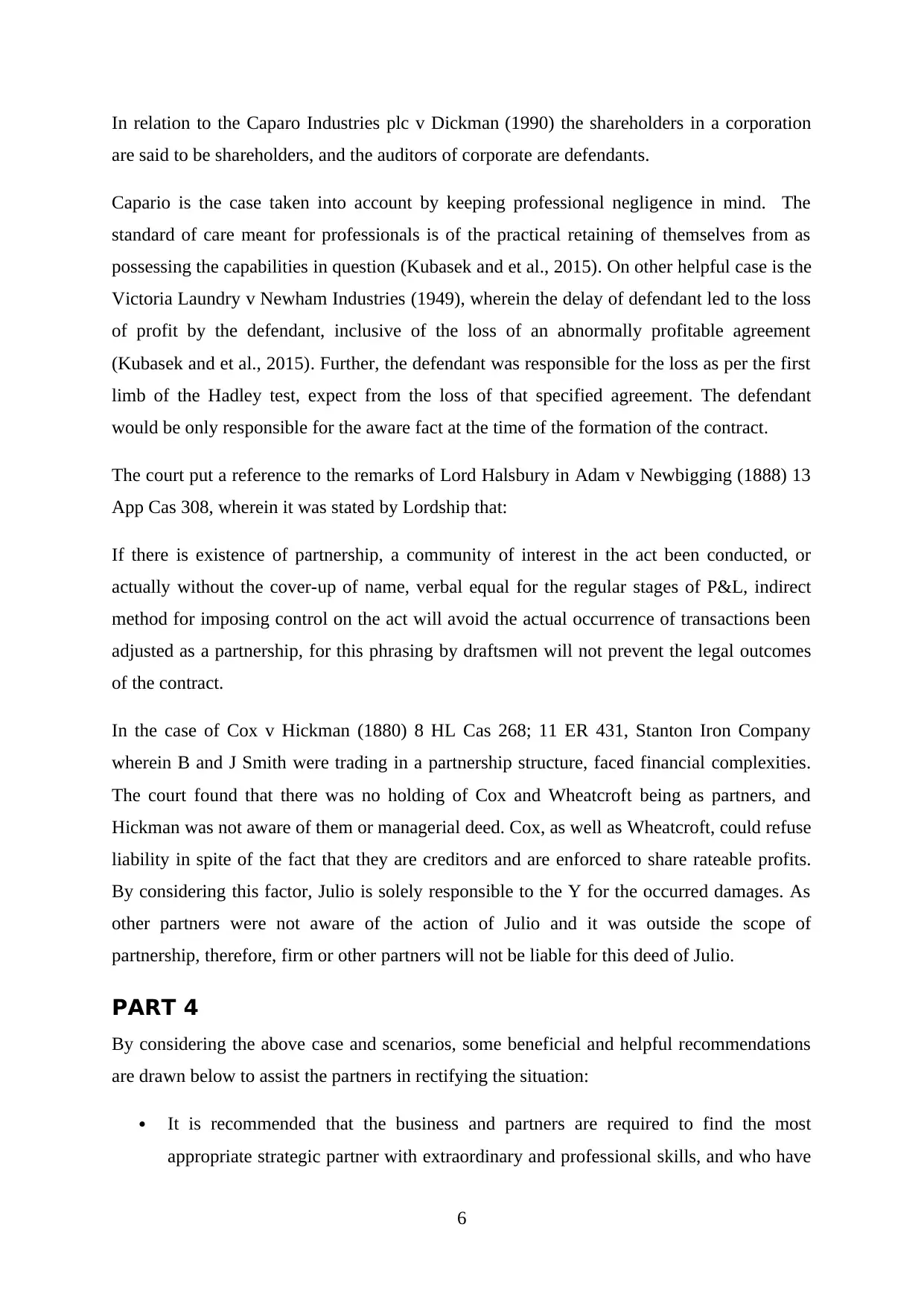
In relation to the Caparo Industries plc v Dickman (1990) the shareholders in a corporation
are said to be shareholders, and the auditors of corporate are defendants.
Capario is the case taken into account by keeping professional negligence in mind. The
standard of care meant for professionals is of the practical retaining of themselves from as
possessing the capabilities in question (Kubasek and et al., 2015). On other helpful case is the
Victoria Laundry v Newham Industries (1949), wherein the delay of defendant led to the loss
of profit by the defendant, inclusive of the loss of an abnormally profitable agreement
(Kubasek and et al., 2015). Further, the defendant was responsible for the loss as per the first
limb of the Hadley test, expect from the loss of that specified agreement. The defendant
would be only responsible for the aware fact at the time of the formation of the contract.
The court put a reference to the remarks of Lord Halsbury in Adam v Newbigging (1888) 13
App Cas 308, wherein it was stated by Lordship that:
If there is existence of partnership, a community of interest in the act been conducted, or
actually without the cover-up of name, verbal equal for the regular stages of P&L, indirect
method for imposing control on the act will avoid the actual occurrence of transactions been
adjusted as a partnership, for this phrasing by draftsmen will not prevent the legal outcomes
of the contract.
In the case of Cox v Hickman (1880) 8 HL Cas 268; 11 ER 431, Stanton Iron Company
wherein B and J Smith were trading in a partnership structure, faced financial complexities.
The court found that there was no holding of Cox and Wheatcroft being as partners, and
Hickman was not aware of them or managerial deed. Cox, as well as Wheatcroft, could refuse
liability in spite of the fact that they are creditors and are enforced to share rateable profits.
By considering this factor, Julio is solely responsible to the Y for the occurred damages. As
other partners were not aware of the action of Julio and it was outside the scope of
partnership, therefore, firm or other partners will not be liable for this deed of Julio.
PART 4
By considering the above case and scenarios, some beneficial and helpful recommendations
are drawn below to assist the partners in rectifying the situation:
It is recommended that the business and partners are required to find the most
appropriate strategic partner with extraordinary and professional skills, and who have
6
are said to be shareholders, and the auditors of corporate are defendants.
Capario is the case taken into account by keeping professional negligence in mind. The
standard of care meant for professionals is of the practical retaining of themselves from as
possessing the capabilities in question (Kubasek and et al., 2015). On other helpful case is the
Victoria Laundry v Newham Industries (1949), wherein the delay of defendant led to the loss
of profit by the defendant, inclusive of the loss of an abnormally profitable agreement
(Kubasek and et al., 2015). Further, the defendant was responsible for the loss as per the first
limb of the Hadley test, expect from the loss of that specified agreement. The defendant
would be only responsible for the aware fact at the time of the formation of the contract.
The court put a reference to the remarks of Lord Halsbury in Adam v Newbigging (1888) 13
App Cas 308, wherein it was stated by Lordship that:
If there is existence of partnership, a community of interest in the act been conducted, or
actually without the cover-up of name, verbal equal for the regular stages of P&L, indirect
method for imposing control on the act will avoid the actual occurrence of transactions been
adjusted as a partnership, for this phrasing by draftsmen will not prevent the legal outcomes
of the contract.
In the case of Cox v Hickman (1880) 8 HL Cas 268; 11 ER 431, Stanton Iron Company
wherein B and J Smith were trading in a partnership structure, faced financial complexities.
The court found that there was no holding of Cox and Wheatcroft being as partners, and
Hickman was not aware of them or managerial deed. Cox, as well as Wheatcroft, could refuse
liability in spite of the fact that they are creditors and are enforced to share rateable profits.
By considering this factor, Julio is solely responsible to the Y for the occurred damages. As
other partners were not aware of the action of Julio and it was outside the scope of
partnership, therefore, firm or other partners will not be liable for this deed of Julio.
PART 4
By considering the above case and scenarios, some beneficial and helpful recommendations
are drawn below to assist the partners in rectifying the situation:
It is recommended that the business and partners are required to find the most
appropriate strategic partner with extraordinary and professional skills, and who have
6

the full knowledge of acts and what actions are required to be done to prevent
damages. It is important that every partner is aware of the latest rulings and acts so
that they can make decisions and carry acts by the same. Partners must be cautious
and carry every action after considering their impacts and consequences
Partners are recommended to make use of business structures in a manner to regulate
the legit practice. Obligation to manage professional as well as ethical rules must be
put in place and made accessible to partners, and should be free to opt from the most
suitable business structure.
As seen in the above case, the partners did not possess a formal or written partnership
agreement due to which they suffered from conflicts. It is essential to form a written
agreement before entering into a partnership to avoid any kind of conflict or loss. It is
very important to have an appropriate agreement in place to set precise partnership
agreements documented by lawyers. The aim of the partnership agreement is to secure
the partner’s investment within the business, managing the governance of business,
clearly defining the rules and rights of the partners and identifying the involvement
rules of partners. A written agreement will minimize the risk of conflicts and
misunderstanding among the owners. A written agreement helps business partners in
many ways, as it avoids the default rule of the state, and by this partners will also
have full control over the business, agreement on significant issues would be easy also
it facilitates in eliminating disruptive aspects while protecting the investment of all
business partners. Further, it is strongly recommended that partners must place written
partnership agreement to highlight business ownership and duties of each partner.
The business partners can move on to the structure of the company; it is because
partners will not be responsible for the debts of the company, and there be no
restriction and bind on them. Also, this business structure will ensure ownership of
company on a full basis.
CONCLUSION
In accordance with the present study, conclusion can be drawn that business structure of
partnership has several pros and cons. Therefore, individuals are recommended to have a
proper analysis of available business structure before the selection. The present case study
shows that individual is considered to be a partner if all characteristics are satisfied
properly. Further, partners are joint as well as individually responsible for their actions thus
they are required to operate ethically along with considering their professional
7
damages. It is important that every partner is aware of the latest rulings and acts so
that they can make decisions and carry acts by the same. Partners must be cautious
and carry every action after considering their impacts and consequences
Partners are recommended to make use of business structures in a manner to regulate
the legit practice. Obligation to manage professional as well as ethical rules must be
put in place and made accessible to partners, and should be free to opt from the most
suitable business structure.
As seen in the above case, the partners did not possess a formal or written partnership
agreement due to which they suffered from conflicts. It is essential to form a written
agreement before entering into a partnership to avoid any kind of conflict or loss. It is
very important to have an appropriate agreement in place to set precise partnership
agreements documented by lawyers. The aim of the partnership agreement is to secure
the partner’s investment within the business, managing the governance of business,
clearly defining the rules and rights of the partners and identifying the involvement
rules of partners. A written agreement will minimize the risk of conflicts and
misunderstanding among the owners. A written agreement helps business partners in
many ways, as it avoids the default rule of the state, and by this partners will also
have full control over the business, agreement on significant issues would be easy also
it facilitates in eliminating disruptive aspects while protecting the investment of all
business partners. Further, it is strongly recommended that partners must place written
partnership agreement to highlight business ownership and duties of each partner.
The business partners can move on to the structure of the company; it is because
partners will not be responsible for the debts of the company, and there be no
restriction and bind on them. Also, this business structure will ensure ownership of
company on a full basis.
CONCLUSION
In accordance with the present study, conclusion can be drawn that business structure of
partnership has several pros and cons. Therefore, individuals are recommended to have a
proper analysis of available business structure before the selection. The present case study
shows that individual is considered to be a partner if all characteristics are satisfied
properly. Further, partners are joint as well as individually responsible for their actions thus
they are required to operate ethically along with considering their professional
7
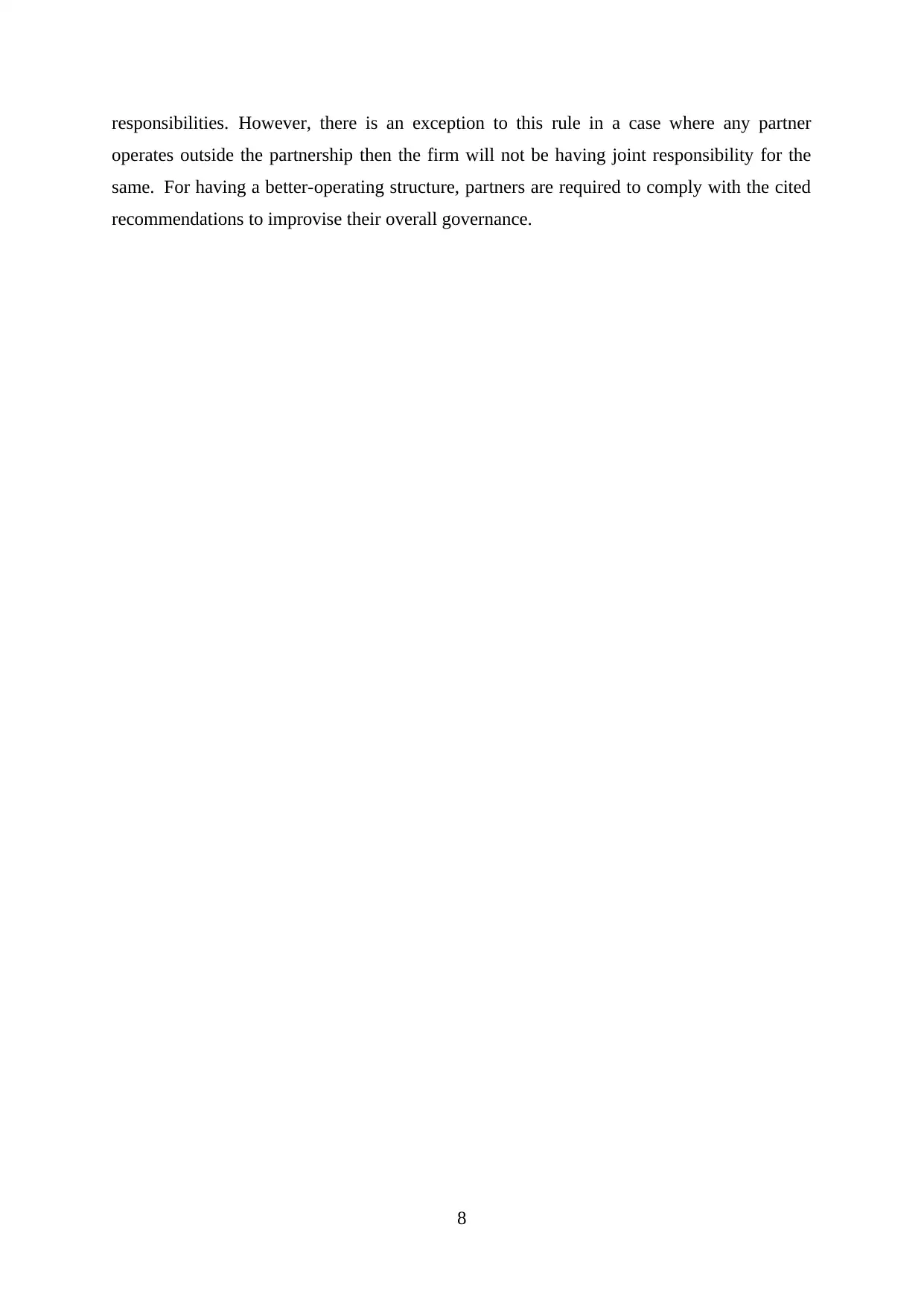
responsibilities. However, there is an exception to this rule in a case where any partner
operates outside the partnership then the firm will not be having joint responsibility for the
same. For having a better-operating structure, partners are required to comply with the cited
recommendations to improvise their overall governance.
8
operates outside the partnership then the firm will not be having joint responsibility for the
same. For having a better-operating structure, partners are required to comply with the cited
recommendations to improvise their overall governance.
8
Secure Best Marks with AI Grader
Need help grading? Try our AI Grader for instant feedback on your assignments.
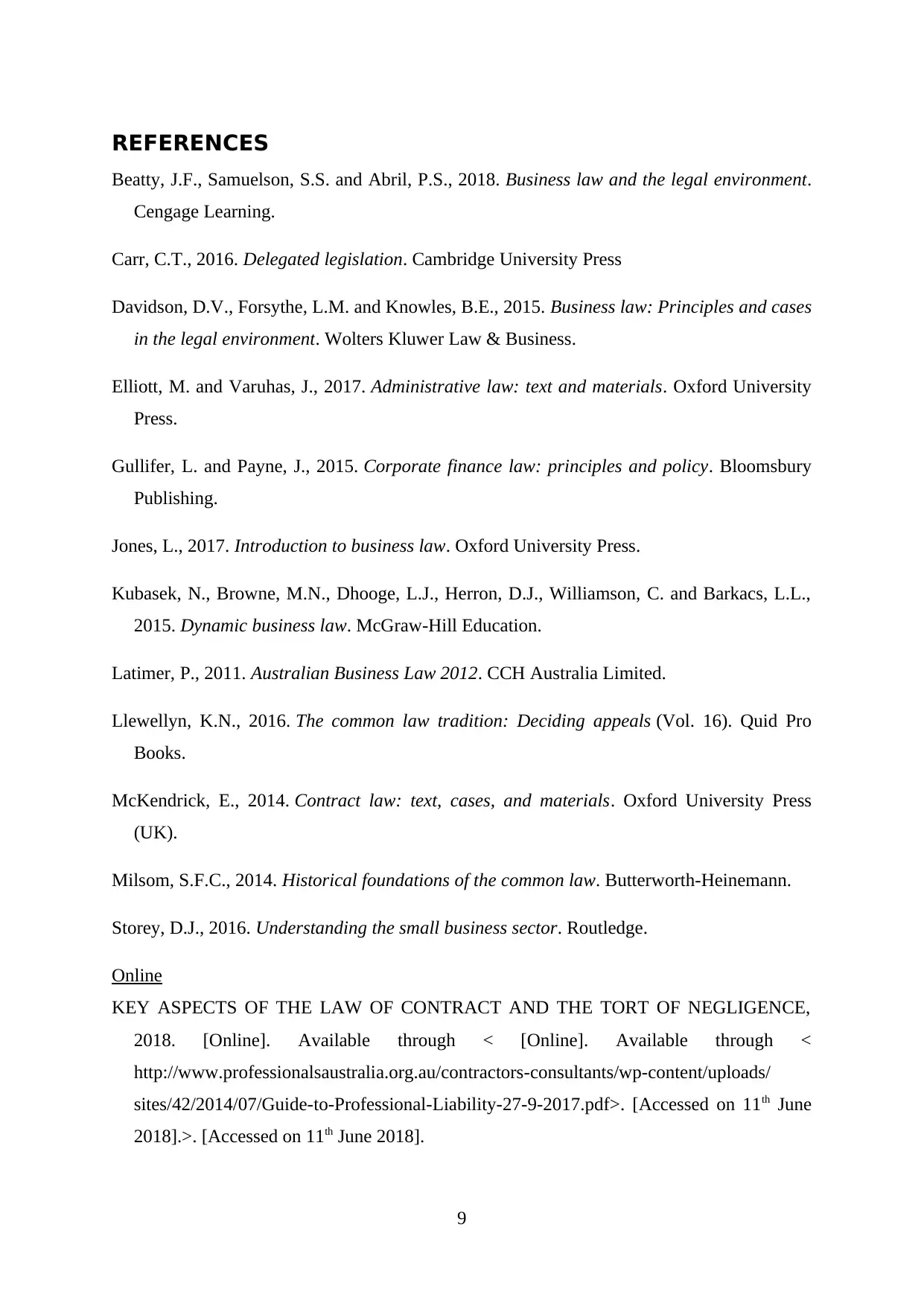
REFERENCES
Beatty, J.F., Samuelson, S.S. and Abril, P.S., 2018. Business law and the legal environment.
Cengage Learning.
Carr, C.T., 2016. Delegated legislation. Cambridge University Press
Davidson, D.V., Forsythe, L.M. and Knowles, B.E., 2015. Business law: Principles and cases
in the legal environment. Wolters Kluwer Law & Business.
Elliott, M. and Varuhas, J., 2017. Administrative law: text and materials. Oxford University
Press.
Gullifer, L. and Payne, J., 2015. Corporate finance law: principles and policy. Bloomsbury
Publishing.
Jones, L., 2017. Introduction to business law. Oxford University Press.
Kubasek, N., Browne, M.N., Dhooge, L.J., Herron, D.J., Williamson, C. and Barkacs, L.L.,
2015. Dynamic business law. McGraw-Hill Education.
Latimer, P., 2011. Australian Business Law 2012. CCH Australia Limited.
Llewellyn, K.N., 2016. The common law tradition: Deciding appeals (Vol. 16). Quid Pro
Books.
McKendrick, E., 2014. Contract law: text, cases, and materials. Oxford University Press
(UK).
Milsom, S.F.C., 2014. Historical foundations of the common law. Butterworth-Heinemann.
Storey, D.J., 2016. Understanding the small business sector. Routledge.
Online
KEY ASPECTS OF THE LAW OF CONTRACT AND THE TORT OF NEGLIGENCE,
2018. [Online]. Available through < [Online]. Available through <
http://www.professionalsaustralia.org.au/contractors-consultants/wp-content/uploads/
sites/42/2014/07/Guide-to-Professional-Liability-27-9-2017.pdf>. [Accessed on 11th June
2018].>. [Accessed on 11th June 2018].
9
Beatty, J.F., Samuelson, S.S. and Abril, P.S., 2018. Business law and the legal environment.
Cengage Learning.
Carr, C.T., 2016. Delegated legislation. Cambridge University Press
Davidson, D.V., Forsythe, L.M. and Knowles, B.E., 2015. Business law: Principles and cases
in the legal environment. Wolters Kluwer Law & Business.
Elliott, M. and Varuhas, J., 2017. Administrative law: text and materials. Oxford University
Press.
Gullifer, L. and Payne, J., 2015. Corporate finance law: principles and policy. Bloomsbury
Publishing.
Jones, L., 2017. Introduction to business law. Oxford University Press.
Kubasek, N., Browne, M.N., Dhooge, L.J., Herron, D.J., Williamson, C. and Barkacs, L.L.,
2015. Dynamic business law. McGraw-Hill Education.
Latimer, P., 2011. Australian Business Law 2012. CCH Australia Limited.
Llewellyn, K.N., 2016. The common law tradition: Deciding appeals (Vol. 16). Quid Pro
Books.
McKendrick, E., 2014. Contract law: text, cases, and materials. Oxford University Press
(UK).
Milsom, S.F.C., 2014. Historical foundations of the common law. Butterworth-Heinemann.
Storey, D.J., 2016. Understanding the small business sector. Routledge.
Online
KEY ASPECTS OF THE LAW OF CONTRACT AND THE TORT OF NEGLIGENCE,
2018. [Online]. Available through < [Online]. Available through <
http://www.professionalsaustralia.org.au/contractors-consultants/wp-content/uploads/
sites/42/2014/07/Guide-to-Professional-Liability-27-9-2017.pdf>. [Accessed on 11th June
2018].>. [Accessed on 11th June 2018].
9
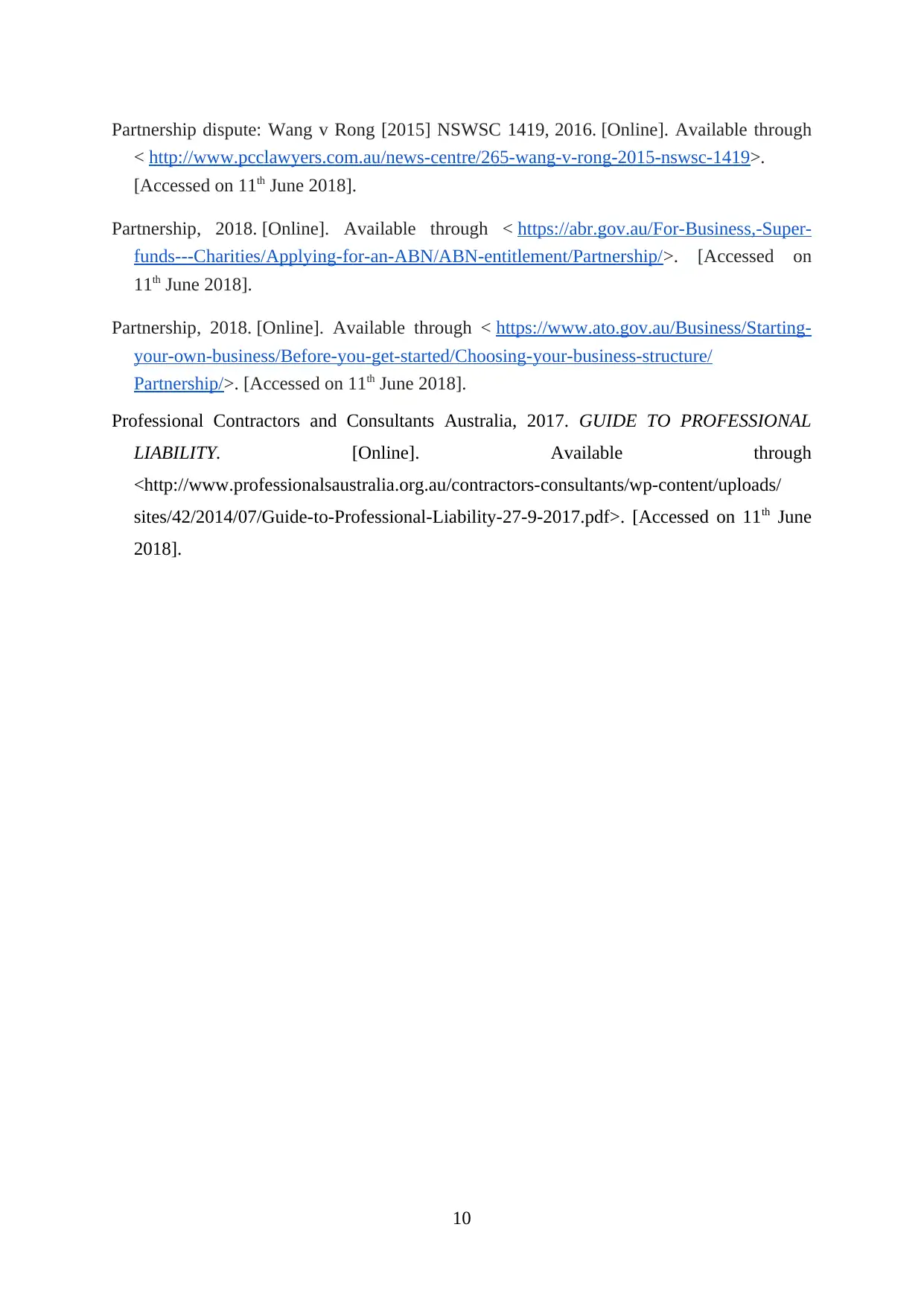
Partnership dispute: Wang v Rong [2015] NSWSC 1419, 2016. [Online]. Available through
< http://www.pcclawyers.com.au/news-centre/265-wang-v-rong-2015-nswsc-1419>.
[Accessed on 11th June 2018].
Partnership, 2018. [Online]. Available through < https://abr.gov.au/For-Business,-Super-
funds---Charities/Applying-for-an-ABN/ABN-entitlement/Partnership/>. [Accessed on
11th June 2018].
Partnership, 2018. [Online]. Available through < https://www.ato.gov.au/Business/Starting-
your-own-business/Before-you-get-started/Choosing-your-business-structure/
Partnership/>. [Accessed on 11th June 2018].
Professional Contractors and Consultants Australia, 2017. GUIDE TO PROFESSIONAL
LIABILITY. [Online]. Available through
<http://www.professionalsaustralia.org.au/contractors-consultants/wp-content/uploads/
sites/42/2014/07/Guide-to-Professional-Liability-27-9-2017.pdf>. [Accessed on 11th June
2018].
10
< http://www.pcclawyers.com.au/news-centre/265-wang-v-rong-2015-nswsc-1419>.
[Accessed on 11th June 2018].
Partnership, 2018. [Online]. Available through < https://abr.gov.au/For-Business,-Super-
funds---Charities/Applying-for-an-ABN/ABN-entitlement/Partnership/>. [Accessed on
11th June 2018].
Partnership, 2018. [Online]. Available through < https://www.ato.gov.au/Business/Starting-
your-own-business/Before-you-get-started/Choosing-your-business-structure/
Partnership/>. [Accessed on 11th June 2018].
Professional Contractors and Consultants Australia, 2017. GUIDE TO PROFESSIONAL
LIABILITY. [Online]. Available through
<http://www.professionalsaustralia.org.au/contractors-consultants/wp-content/uploads/
sites/42/2014/07/Guide-to-Professional-Liability-27-9-2017.pdf>. [Accessed on 11th June
2018].
10
1 out of 12
Related Documents
Your All-in-One AI-Powered Toolkit for Academic Success.
+13062052269
info@desklib.com
Available 24*7 on WhatsApp / Email
![[object Object]](/_next/static/media/star-bottom.7253800d.svg)
Unlock your academic potential
© 2024 | Zucol Services PVT LTD | All rights reserved.





